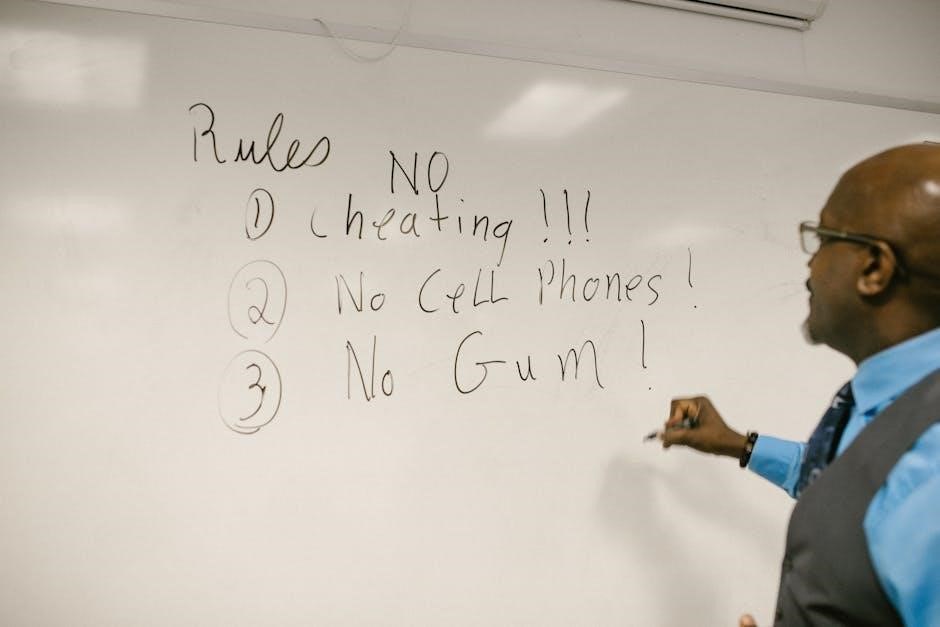Bomb instructions provide critical guidance for the safe handling, deployment, and detonation of explosive devices. They ensure proper use, minimizing risks and maximizing effectiveness in military or demolition contexts.
Definition of Bombs and Their Types
A bomb is a device designed to release energy in an explosive manner, often causing damage or harm. Types of bombs vary widely, including aerial bombs, improvised explosive devices (IEDs), and nuclear bunker busters. Aerial bombs are dropped from aircraft and are used in military operations, while IEDs are often used in asymmetric warfare. Nuclear bunker busters are specialized bombs designed to penetrate underground structures before detonating. Other types include explosive ordnance, such as grenades and landmines, which are used for specific tactical purposes. Each type of bomb is engineered for a particular purpose, ranging from targeted destruction to widespread devastation. Understanding these distinctions is crucial for effective military strategies, bomb disposal, and public safety measures;
Historical Development of Bomb Technology
The development of bomb technology traces back to ancient times, with early explosives like gunpowder being used in rudimentary devices. Over centuries, advancements in chemistry and engineering led to more sophisticated designs. During World War I and II, aerial bombs became prominent, with nations developing larger and more destructive ordnance. The invention of nuclear weapons marked a significant leap, introducing bombs capable of unprecedented devastation. Modern technology has further refined bomb design, with precision-guided munitions and improvised explosive devices (IEDs) becoming prevalent. Today, bomb technology continues to evolve, with a focus on both military applications and counter-terrorism measures. This historical progression highlights humanity’s ingenuity and the tragic consequences of conflict.

Military and Civilian Use of Bombs
Bombs are primarily used in military combat for destruction, while civilian applications focus on controlled demolitions, construction, and safely deactivating explosive ordnance for public safety.
Aerial Bombs and Their Role in Warfare
Aerial bombs are explosive devices dropped from aircraft to destroy targets on the ground or at sea. They play a critical role in modern warfare, enabling air forces to strike enemy positions with precision and force. Historically, aerial bombs were used extensively in World War II, where they caused widespread destruction in both military and civilian areas. Today, advanced technologies like precision-guided munitions have enhanced their accuracy, reducing collateral damage. Aerial bombs remain a key component of military strategy, allowing for rapid deployment and high-impact strikes. Their effectiveness in disabling enemy infrastructure and morale makes them a cornerstone of airpower in contemporary conflicts. This underscores their enduring relevance in shaping the outcomes of modern warfare.

Civilian Applications of Explosive Ordnance
Civilian applications of explosive ordnance focus on peaceful uses, such as demolition and construction. Controlled detonations are used to clear land, demolish structures, and create infrastructure like tunnels and canals. In mining, explosives are essential for extracting minerals and ores. Additionally, explosive ordnance is used in search and rescue operations to break through debris. Firefighters and emergency responders employ explosives to create firebreaks or access disaster zones. Environmental conservation also benefits, as explosives are used to disrupt illegal wildlife poaching activities. These applications highlight the versatility of explosive technology beyond military contexts, contributing to societal development and safety. Proper training and regulation ensure that these powerful tools are used responsibly and effectively in civilian settings, balancing utility with public safety concerns.

Explosive Ordnance Disposal (EOD) Training
EOD training equips technicians with skills to safely detect, disarm, and dispose of explosive devices. Programs include structured courses, certification, and hands-on exercises to ensure expertise in handling threats.
Overview of EOD Training Programs
Explosive Ordnance Disposal (EOD) training programs are structured to equip technicians with the necessary skills to handle explosive threats safely. These programs typically begin with foundational courses, such as EOD Level 1, which introduces basic concepts and safety protocols. Advanced levels, like EOD Level 2 and 3, focus on specialized techniques for disarming complex devices, including improvised explosive devices (IEDs) and underwater mines. Training includes hands-on exercises, theoretical knowledge, and real-world scenario simulations. Certification is often required, ensuring technicians meet international standards. These programs are designed to progress from basic to advanced skills, preparing EOD operators for the challenges of bomb disposal in various environments, from military zones to civilian settings. The goal is to ensure public safety by effectively mitigating explosive threats.
Structure of EOD Training Courses
EOD training courses are meticulously structured to ensure comprehensive skill development. They typically begin with EOD Level 1, focusing on foundational knowledge, safety protocols, and basic explosive device recognition. As trainees progress, advanced levels introduce specialized techniques for disarming complex devices, including improvised explosive devices (IEDs) and underwater mines. The curriculum combines theoretical instruction with hands-on exercises, emphasizing practical application. Real-world scenario simulations are integral, preparing technicians for diverse operational environments. Certification is awarded upon successful completion of each level, ensuring adherence to international standards. The structured progression from basic to advanced training equips EOD operators with the expertise needed to address evolving threats effectively. Continuous updates to the curriculum reflect emerging challenges, such as exploding drones and new explosive technologies.
Importance of EOD Training for Public Safety
EOD training is critical for safeguarding communities from explosive threats. It equips technicians with the skills to safely neutralize devices, preventing loss of life and property damage. By mitigating risks posed by bombs, EOD training ensures public spaces remain secure. Additionally, it enables first responders to handle emergencies effectively, reducing panic and fostering a safer environment. The specialized knowledge gained through EOD programs empowers professionals to address diverse threats, ranging from traditional bombs to improvised explosive devices (IEDs) and underwater mines. Proper training also ensures adherence to international protocols, minimizing collateral damage. The consequences of improper handling are severe, making EOD training indispensable for protecting the public and maintaining order in crisis situations. Thus, it is a cornerstone of modern public safety strategies.

Bomb Disposal Techniques
Bomb disposal involves systematic detection, analysis, and neutralization of explosive devices. Trained technicians use specialized tools and protocols to safely disarm threats, ensuring minimal risk to people and infrastructure.

Detection and Identification of Explosive Devices
Detection and identification of explosive devices are critical steps in bomb disposal. Techniques include X-ray scanning, sniffer dogs, and manual inspection to locate hidden threats. Advanced technologies, such as thermal imaging and acoustic sensors, aid in detecting concealed explosives. Once identified, technicians analyze the device’s structure, wiring, and components to determine its type and detonation mechanism. This process requires extensive training and expertise to recognize patterns and anomalies. Proper identification ensures the use of appropriate disarmament methods, minimizing risks to personnel and surrounding areas. Protocols often involve cataloging known devices and cross-referencing with databases to streamline the process. Effective detection and identification are foundational to successful bomb disposal operations, ensuring safety and efficiency in high-stakes situations.
Tools and Equipment Used in Bomb Disposal
Bomb disposal requires specialized tools to ensure safe and effective neutralization of explosive devices. EOD technicians use advanced equipment such as portable X-ray scanners to visualize internal components and robotic systems for remote handling. Thermal imaging cameras detect heat signatures, while explosive vapor detectors identify chemical traces. Disruptors, like water cannons, are employed to disable devices without triggering detonation. Communication devices, including encrypted radios, maintain team coordination. These tools, combined with meticulous training, enable technicians to manage high-risk situations efficiently, ensuring public safety and minimizing collateral damage.
Safe Disarmament and Disposal Methods
Safe disarmament and disposal of explosive devices require precise techniques to prevent accidental detonation. Trained EOD technicians follow protocols such as manual neutralization, where components are carefully dismantled. Robotic systems are often used to minimize human risk. Controlled detonations are employed when defusing is impractical, using specialized charges to render the device inert. Disposal methods include secure transportation to designated facilities for safe destruction. These procedures ensure the protection of personnel, civilians, and the environment from potential hazards. Continuous training and adherence to international standards are critical to maintaining operational safety and effectiveness in bomb disposal operations.

Modern Threats and Challenges

Modern threats include improvised explosive devices, underwater mines, and exploding drones, requiring advanced detection and disposal strategies to counter these evolving dangers effectively.

Improvised Explosive Devices (IEDs) and Their Impact
Improvised Explosive Devices (IEDs) are crude, homemade bombs designed to cause widespread destruction. Often used in asymmetric warfare, they target civilians, infrastructure, and military personnel. Constructed from readily available materials, IEDs are highly unpredictable and difficult to detect, making them a significant threat. Their mobility and ease of deployment allow insurgents to strike unpredictably, creating fear and instability. The impact of IEDs extends beyond physical damage, as they disrupt daily life and undermine public confidence. EOD teams face immense challenges in identifying and neutralizing these devices due to their varied designs and triggering mechanisms. The psychological toll on communities and first responders is immense, emphasizing the need for advanced training and countermeasures to mitigate their deadly effects effectively.
Underwater Mines and Their Disposal
Underwater mines are explosive devices planted beneath water surfaces to target ships, submarines, and other underwater vehicles. Their disposal poses significant challenges due to their concealed nature and the risks of accidental detonation. EOD teams employ specialized techniques to detect and neutralize these threats, often using advanced sonar technology and remotely operated vehicles (ROVs). The process involves careful identification of the mine type, followed by precise disarming or controlled detonation. Underwater mine disposal requires highly skilled personnel and sophisticated equipment to ensure safety and effectiveness. The impact of these devices extends beyond military conflicts, as they can disrupt maritime trade and endanger civilian lives long after hostilities cease, making their safe removal critical for global security and economic stability.
Emerging Threats: Exploding Drones and New Technologies
Exploding drones have emerged as a significant threat, combining aerial mobility with explosive payloads. These devices can be deployed in swarms, overwhelming defenses and targeting critical infrastructure. Modern technologies, such as GPS guidance and autonomous systems, enable precise delivery of ordnance. The use of 3D printing and readily available components allows adversaries to manufacture these weapons with ease. EOD teams must adapt by integrating advanced counter-drone measures and AI-driven detection systems. The evolution of drone technology necessitates continuous training and innovation in bomb disposal tactics to mitigate these dynamic threats effectively; As drone capabilities advance, so too must the strategies to counter them, ensuring public safety and national security in an increasingly complex landscape.

International Cooperation and Bomb Disposal
International cooperation in bomb disposal involves shared strategies, joint training, and resource sharing to enhance capabilities and address explosive threats collectively worldwide.
Role of UN Peacekeepers in EOD Missions
UN Peacekeepers play a vital role in Explosive Ordnance Disposal (EOD) missions globally, ensuring the safe disposal of explosive devices in conflict zones. Their expertise is crucial in maintaining peace and stability. Trained to handle various threats, including landmines and improvised explosive devices, they protect civilians and enable humanitarian aid delivery. By mentoring local forces, they build long-term capacity, fostering self-sufficiency in post-conflict regions. Their contributions are integral to UN missions, safeguarding communities and preventing catastrophic incidents, thus upholding international security and humanitarian efforts effectively.
Global Training Initiatives for Bomb Disposal
Global training initiatives for bomb disposal are essential for standardizing practices and enhancing expertise worldwide. Organizations like Med-Eng and ISSEE offer comprehensive programs, including free online training, to equip EOD operators and bomb squad technicians. These initiatives target military, police, and civilian agencies, ensuring a unified approach to explosive ordnance disposal. Programs such as the six-course certificate for bomb disposal technicians and the IMAS Level 3 EOD course provide advanced knowledge and hands-on skills. Such training fosters international collaboration, enabling professionals to address emerging threats like improvised explosive devices and underwater mines effectively. By promoting global standards, these initiatives ensure public safety and contribute to conflict resolution, making them a cornerstone of modern explosive ordnance management.
Case Studies of Successful Bomb Disposal Operations
Case studies of successful bomb disposal operations highlight the expertise and precision required in explosive ordnance disposal. For instance, in Cornwall, a wartime bomb discovered near railway tracks was safely defused by a Ministry of Defence team, ensuring public safety. Similarly, in Englewood Beach, a World War II-era relic was successfully disposed of, preventing potential harm. In Hyderabad, a bomb threat at Begumpet airport was resolved efficiently, minimizing disruption. These examples demonstrate the critical role of EOD technicians in mitigating threats. Such operations rely on advanced training, cutting-edge tools, and coordinated efforts between local and international agencies. These case studies serve as valuable learning tools, enhancing global EOD practices and fostering international cooperation in combating explosive threats.



